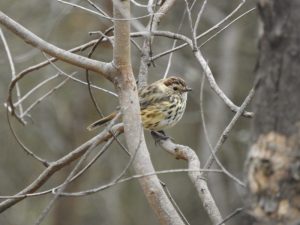
Speckled Warbler, Chthonicola sagittata spotted in the nature reserve by Dusty (CNM)
Give a hand on Sunday, 18 June and help transform Mount Majura’s weedy woodland east of The Fair into native wildlife habitat; enjoy the little woodland birds foraging among planted trees and shrubs and learn about the work of volunteers to reclaim grassy woodland in the area.
When: Sunday, 18 June, 1pm – 4pm; give as much of your time as you want; please come early for an introduction if you can.
Meet: Nature park entrance Tay / Ian Nicol Streets, The Fair, North Watson; view this map
Bring: Sun protection, sturdy shoes and appropriate clothes; tools and afternoon tea will be provided.
Inquiries: projects@majura.org
Download this poster to promote the working party
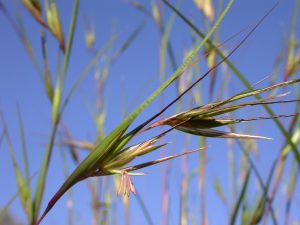
Flowering Kangaroo grass, Themeda australis (W.Pix). The iconic species once common of grassy ecosystems has been almost lost in the Mt Majura nature reserve.
Help with these tasks
Spreading wood chip mulch. Mulch reduces erosion and works as a soil conditioner that helps native plants to establish.
Direct seeding Kangaroo grass and installing protective wire mesh guards. Much of the native ground layer has been lost and replaced by herbaceous weeds as a result of overgrazing and other degrading activities. The reintroduction of native grass and local wildflowers complements weed control, increases plant diversity, reduces erosion and provides habitat for local invertebrates, lizards and birds.
About The Fair Project
Since the start of The Fair project in 2012 volunteers replaced hundreds of woody weeds with local shrubs and trees to provide food, nesting and protective habitat for declining woodland birds that visit and live in the nature reserve east of The Fair. We hope our work ensures vulnerable species such as Scarlet Robins and Speckled Warblers will be visiting the area for many years to come.
Starting in the south and working towards the north volunteers spent 1000s of hours to improve the ground cover layer by controlling herbaceous weeds *, manually loosening compacted soil, spreading wood chip mulch and woody debris – making best use of removed woody weeds, collecting seeds, direct seeding various local grasses and planting wildflowers.
*The most common herbaceous weeds are Paterson’s Curse, St John’s Wort, Saffron thistle, Scotch thistle, Slender thistle, Spear thistle, Variegated thistle, Hirschfeldia, Horehound, Serrated Tussock.
Work in Progress
The photographs below show northwest and northeast views of an area in the reserve east of The Fair taken over 4 years from May 2014 to April 2017. The most noticeable weed, Paterson’s Curse formed dense carpets in autumn 2014. Many volunteer’s hours later in autumn 2017, this weed occurs in a few scattered stands hardly visible among the native grass that had been direct seeded in a cover of wood chip mulch.
The 2 sets of 4 photographs shown below were taken on 13 May 2014, 2 June 2015, 31 May 2016, and 11 April 2017. The first set shows a northwest view downhill towards gully in the north from close to the big conifer (visible on the left hand side) and the second set shows a northeast view from close to the conifer (the water container visible in the photograph sets is the same)
Northwest view
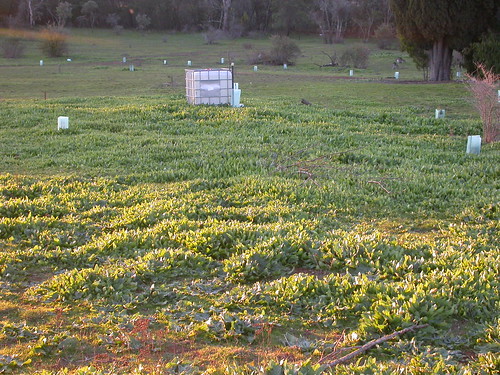
May 2014

June 2015

May 2016
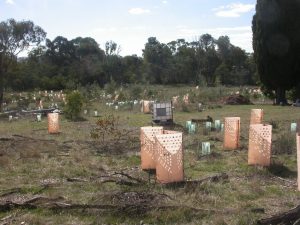
April 2017
Northeast view
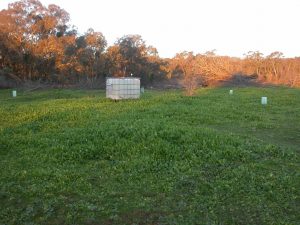
May 2014
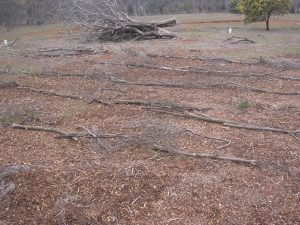
June 2015

May 2016
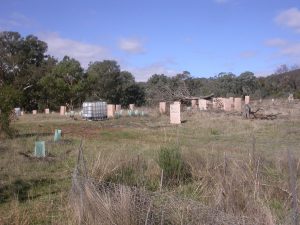
April 2017


